How to clean a chimney: an overview of the best 3 ways to clean the chimney from soot
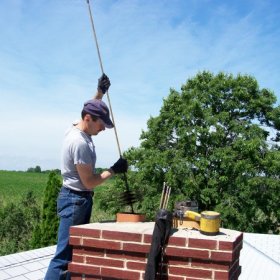
The owners of stoves and fireplaces are well aware of the need for regular maintenance of their heating boilers. No matter how perfect the design, chimney cleaning is required. Various factors influence its clogging speed: operating conditions, instrument design, quality and type of fuel, etc. However, even in the most ideal conditions, at least once a year, the chimney must be cleaned. Often this operation is carried out by employees of special companies, but if you wish, you can handle it yourself.
Content
Why is it necessary to clean the chimney?
When fuel burns in the heater, soot is released. Warm air lifts it up, where it settles on the walls of the chimney. Over time, soot accumulates, its layer becomes more and more powerful. This leads to unpleasant consequences:
- The smoke exhaust channel narrows, resulting in reduced draft.
- Chimney wall wear is accelerated.
- The efficiency of the heating device decreases.
- The probability of fire inside the chimney increases.
Troubles can be prevented only by timely conducting high-quality cleaning of the chimney from accumulated soot.
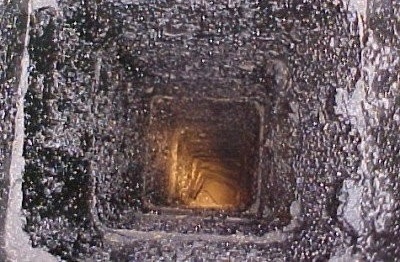
Soot is deposited inside the chimney and closes the space of the outlet channel. Traction is reduced, the efficiency of the heater decreases and the risk of fire increases
You may also find the article on how to make a brick chimney the right way:https://aquatech.tomathouse.com/en/otoplenie/dyimohod-iz-kirpicha-svoimi-rukami.html
Chimney cleaning methods
All options for clearing the smoke channel can be divided into three groups.
Option # 1 - folk remedies
The most common remedy for soot accumulation in the chimney is rock salt. It is usually poured onto the fuel during combustion. However, this option can be considered, rather, as a prevention of soot formation. He will not help to radically clean the pipe.
A more effective means for cleaning chimneys is potato peeling or simply chopped potatoes. Their number is determined by the size of the heater, but on average it usually goes around a bucket. The purifications spill right into the fire. The starch released along with the steam softens the soot and it leaves the pipe. After the procedure, it is necessary to clean the oven. Sometimes such an operation is carried out before mechanical cleaning, which is much easier.
Another remedy is aspen firewood. Several armfuls of such fuel are burned in a furnace. However, you must immediately make a reservation that this is a rather dangerous way. It involves heating the chimney to very high temperatures, as a result of which the soot begins to burn out. Before using this method, you should make sure the strength of the chimney.In addition, soot deposits must be small, otherwise even the most durable pipe will not withstand the loads and collapse.
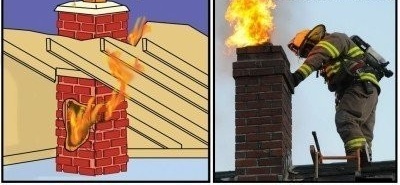
Soot is deposited inside the chimney and closes the space of the outlet channel. Traction is reduced, the efficiency of the heater decreases and the risk of fire increases
Option # 2 - chemical compounds
The industry produces many tools designed to clean the chimney. These are a variety of powders, liquids and briquettes. They are added to the furnace during fuel combustion. They light up and release substances that are harmless to humans, which destroy deposits on the walls of the smoke channel, which crumble down. Popular remedies include PCC or an anti-burn chemical composition. A special powder is laid in the furnace along with firewood. Its amount is strictly standardized: no more than 200 g per ton of fuel.
In search of how to clean your chimney from a small layer of soot, you should pay attention to the Czech tool Kominicek. This powder causes a catalytic reaction when heated, causing the soot to burn at a lower temperature. The most popular is Log-Chimney Sweep, which can be used in all types of devices operating on liquid and solid fuels. Use the product as accumulation of deposits. On average, a fireplace that is lit once or twice a week will require one briquette for six months. But for the boiler, which is constantly used, you need one log in two months. In large fireplaces and stoves, two packages are burned at once.
Before using the Log Chimney Sweep for the first time in the heating season, you should inspect the chimney to make sure that it is not clogged with garbage or foreign objects. The briquette can be burned with or without fuel. However, for maximum efficiency it is laid on hot coals. Before this, the log is taken out of the package, but the wrapper is not removed. You should wait until the briquette flares up, if this does not happen, the wrapper is set on fire from two sides. The action of the active substance lasts for two weeks. Soot is possible all this time. After this period, you should inspect the pipe and clean the firebox.
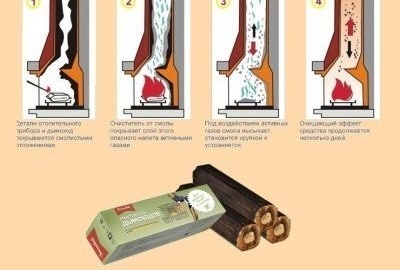
An effective tool for cleaning the chimney is a special log. When burning, it emits volatile substances that destroy soot deposited in the smoke channel
However, it is worth saying a few words about safety (more in the video):
In our next material you will find instructions for installing a steel chimney:https://aquatech.tomathouse.com/en/otoplenie/dimohod/dyimohod-iz-stalnoy-trubyi-svoimi-rukami.html.
Option # 3 - mechanical cleaning
No matter how much humanity has advanced in technology, mechanical cleaning of chimneys, like hundreds of years ago, remains the easiest, most reliable and effective way to remove soot and soot. Depending on which flues need to be cleaned - vertical or horizontal, a variety of scrapers, vanes, brushes and panicles are used. A tool for servicing furnace channels can be made with your own hands or bought in specialized departments of building markets. Most often, a brush-brush is used to remove soot in vertical flues, and in horizontal - a poker and a brush with hard bristles. If necessary, a handle of the desired length is attached to the tool.
Previously, you could turn to the chimney sweep to clean the chimney. Since today people of this profession are extremely rare, we will tell you in detail about how to properly clean the stove or fireplace from soot:
- Clean the furnace of ash and unburned solid fuel residues.
- Close the blower, firebox and all the cleaning doors tightly - remember that soot consists of microscopic particles that can penetrate the narrowest gaps. The open fireplace should be curtained with a thick cloth, which should be thoroughly moistened with water.
- Observe safety precautions and climb the roof. With you you should have a brush-ruff attached to a long rope.
- Inspect the vertical flue for contamination with large debris. If large third-party objects got into the chimney, or the breakaway half of the brick blocked the smoke channel, then it can be released using a rope with a heavy weight in the shape of a ball. Use for this purpose objects of complex shape (with a shifted center of gravity) is not recommended. Often they turn and get stuck in the channels of the furnace, requiring additional effort and time for extraction.
- After removing the blockage, lower the brush with a rag brush and clean the walls along the entire height of the pipe with up and down movements. If the chimney has not been cleaned for a long time, or if raw firewood with a high resin content was used for the furnace, then a thick layer of deposits can be removed only with a metal scraper.
- Check the result of your work and get down. Your next goal is the remaining vertical and horizontal channels. They can be accessed through the cleaning doors. Opening them one by one in the direction from the chimney to the mouth of the furnace, remove carbon deposits with scrapers and hard panicles and dig out the channels with a poker.
- Wide firebox stoves, as well as fireplaces, are also cleaned from the side of the firebox. Lastly, they scrape away carbon from the walls of the fuel chamber and blow it, after which they remove the soot and clean it under and the grate.
Having finished work, close and carefully seal the cleaning doors, conduct a complete wet cleaning of the room. The cleaning procedure is usually carried out twice a year, before the start of the heating season and at the end of it.
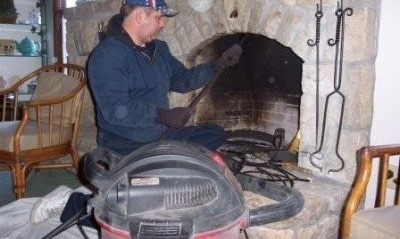
Fireplaces with straight chimneys can be cleaned from below, through the firebox. To do this, use a special metal brush, the handle of which is extended using special extensions
The problem of cleaning the chimney is easily solved. You can choose from several cleaning options. It is only necessary to take into account the amount of deposits accumulated on the walls of the smoke channel. All work, including mechanical cleaning, can be carried out independently. You should familiarize yourself with the instructions and carefully follow them. However, those who are not confident in their abilities or do not want to do dirty work can invite a professional. In any case, a clean chimney will delight its owner with excellent draft and a long service life.
How to reduce soot deposits
Soot and soot are deposited even in the pipes of gas-fired furnaces. What can we say about the burning of solid fuel - for him it is an even more natural process. At the same time, the amount of combustion products deposited on the walls of the chimney can be significantly reduced. To do this, follow a few simple rules:
- No rubbish. Do not burn plastic, polystyrene, rubber and other substances with a high carbon content in the furnace of a solid fuel furnace.
- Harvest firewood in advance. Remember that high-quality dry wood burns with almost no residue, with minimal emission of soot and substances that cause carbon deposits. Among other things, this contributes to a higher combustion temperature, which affects the course of pyrolysis processes. As for raw firewood, when they are used in excess, water vapor is released, as well as substances such as tar, creosote, etc. - they simply do not have time to burn out due to the low temperature. Subsequently, all these resinous substances fall out in the form of hard-to-remove plaque on the ducts of the gas ducts and are the reason for the rapid overgrowth of the channels with soot - it sticks to the sticky substance much more readily.
- Use hardwood. Anyone who drowns the stove on their own knows that the best are oak, hornbeam, beech, aspen and acacia wood. In second place is wood of walnut, apple, cherry, larch, poplar, plane tree, etc. But firewood from coniferous trees (spruce, pine, juniper, etc.) contain a lot of resins, so when using them you will need to clean the oven significantly more often. As, however, when firing birch logs, which are characterized by a high tar content. By the way, fuel briquettes or pellet pellets that are fashionable today are also subject to a thorough audit at the time of purchase. If they are made of pine sawdust or sunflower husk, it is better to bypass such fuel side due to the high content of resins and oily substances.
- Make sure that the firewood burns in the optimal mode. This corresponds to the temperature of the flue gases from 150 to 350 degrees. With reduced heat generation, the wood carbon does not have time to burn in the furnace and flies away with smoke, incidentally falling in the vertical and horizontal channels of the furnace.
In order to achieve the most complete combustion of wood, use the advice of experienced stove makers. Here's what they recommend:
- before laying firewood in the oven, keep them in the room for at least 2-3 days. During this time, they will dry out and warm up to room temperature, which means that they will not only burn better, but will not require additional heat to be preheated;
- Before laying the main batch of wood, heat the combustion chamber by burning wood chips, pieces of cardboard, etc.
- as the wood burns out, regulate the combustion process using a gate or a blower door. Of course, the high temperature in the furnace is good because less soot is formed, but at the same time the heat will not have time to accumulate in the body of the furnace, and will simply fly into the atmosphere;
- Install a combustion indicator on the chimney. With its help, it is possible to more accurately monitor the temperature of the smoke and maintain the heat release process at optimal limits.
Symptoms of an “overgrown” chimney cannot be overlooked. First of all, the color of the smoke changes. If the chimney is clean, it will be light, transparent or white. Accumulated soot begins to burn, which changes the color of the smoke. It becomes more dense and dark. The shade of the flame in the furnace can also change. Under normal circumstances, it will be light orange. If a rich shade of dark orange appears, then it's time to think about how to clean the chimney.
What is better to choose for heating a wooden house, which option is more economical and more profitable, you will learn in our next material:https://aquatech.tomathouse.com/en/otoplenie/documents/otoplenie-v-derevyannom-dome.html.
In any case, even if alarming signs have not appeared, experts recommend conducting an audit of the flue duct at least twice a year. It should be borne in mind that cleaning may be necessary not only in the case of an increase in the soot layer, but also from debris, bird nests, cobwebs, etc. that accidentally get inside. There are many cleaning methods and the optimal one can be selected only after determining the level of pollution, revising the state of the chimney, etc.

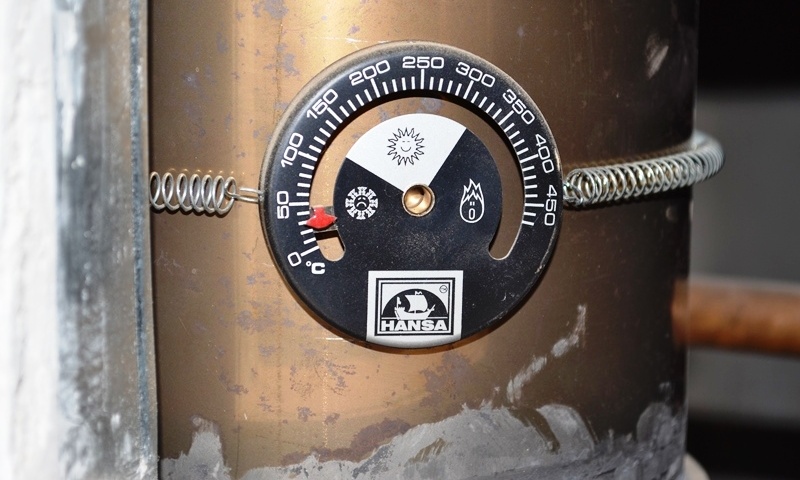
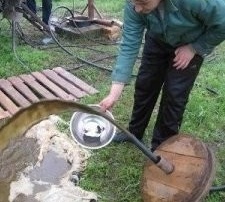
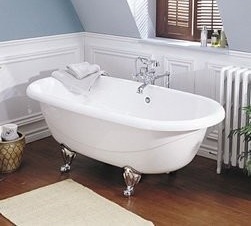
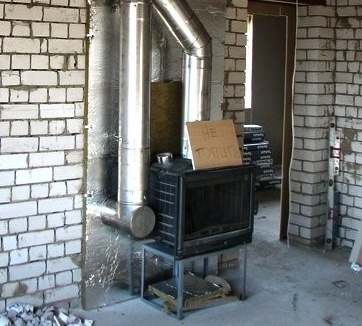
4 comments